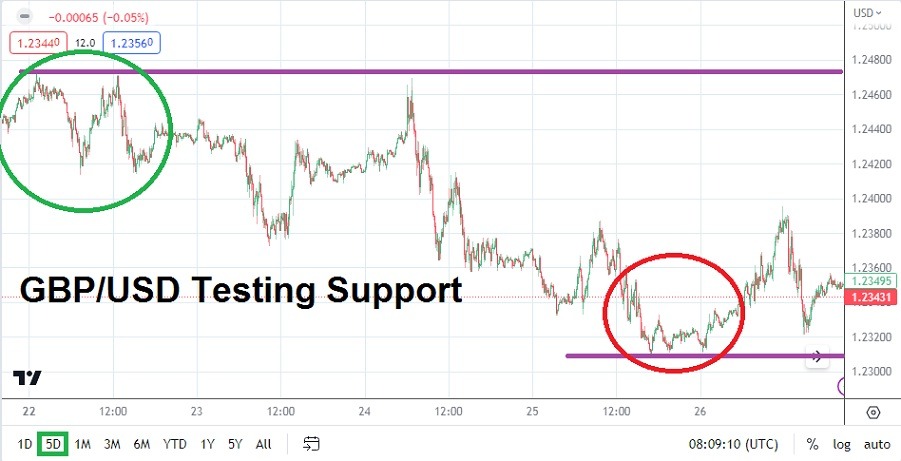Support levels have continued to prove vulnerable in the GBP/USD as nervous trading conditions highlight Forex. The combination of weak U.K economic data and troubling reminders from the U.S. Federal Reserve have made the near and mid-term outlooks for the GBP/USD rather miserable. After trading near a high of 1.26700 on the 8th and 10th of May, the currency pair has developed a bearish trend.
U.S Federal Reserve’s Federal Funds Rate Outlook is Gloomy
The U.S. Federal Reserve has made it clear they remain worried about stubborn inflation in the U.S., and their interest rate policy rhetoric has seemingly opened the door for more increases. The GBP/USD never really challenged the 1.25000 level last week in trading and after experiencing highs near the 1.24725 ratio on Monday and Wednesday began to slip lower with increasing momentum.
Support levels were broken lower and the GBP/USD challenged the 1.23100 mark on Thursday and Friday, before seeing a slight move higher before trading concluded for the week. Speculators need to be aware that tomorrow is a banking holiday in the U.K. and U.S., and this will dramatically lower trading volume which could cause some volatility in the Forex market. However, full transaction power will return on Tuesday and financial institutions will try to decipher their GBP/USD crystal balls nervously.
The ability of the GBP/USD to break below the 1.24000 level and sustain values beneath will cause bullish sentiment to weaken further in the short term. Certainly, there will be reversals upward in the GBP/USD this coming week, but the question is how long the upwards momentum can be carried forth. The GBP/USD ended Friday’s trading near 1.23430 and is within sight of rather intriguing values seen in the first week of April in which the currency pair fell below 1.23000 briefly.
Inflation and Jobs Data from the U.S this Week could affect the GBP/USD
- Eyes will stay focused on the debt ceiling crisis from the U.S. early this week, but supposedly an agreement has been made.
- U.S. consumer sentiment numbers will be published on Tuesday, and the jobs and earnings data this coming Friday could stir the GBP/USD.
- If inflation statistics from the U.S. remain high, financial institutions could escalate nervous market conditions in Forex and the GBP/USD.
GBP/USD Weekly Outlook:
The speculative price range for GBP/USD is 1.22750 to 1.24275
Bullish traders who have believed the GBP/USD must return to the 1.25000 level are likely licking their wounds after last week’s trading. What has been a rather long-term strong bullish trend in the GBP/USD has seen behavioral sentiment the past couple of weeks take a hit due to nervousness regarding U.S central bank policy. The downward motion of the GBP/USD should not be discounted, and traders who insist on looking for reversals higher should not be overly optimistic this coming week and certainly not overly ambitious. The key question early this week for the currency pair is whether the 1.24000 level will be challenged again.
If the GBP/USD cannot mount an attack on the 1.24000 level, and sees trading sustained below the 1.23600 ratio this would be a negative sign. The 1.23600 to 1.23800 range should be watched perhaps early this week. If the GBP/USD remains below these depths on Wednesday, this could set the table for a rather choppy end to the week when financial institutions start to focus on jobs and Average Hourly Earnings from the U.S on Friday.
The GBP/USD may be hard-pressed to demonstrate a run higher this week, and traders looking for upside price action should likely target goals with realistic quick-hitting values. The past two weeks of trading in the GBP/USD has been rather negative, and this week traders should brace form the potential of further headwinds as financial institutions try to gauge what the U.S Federal Reserve will do in a little more than two weeks regarding interest rates.

